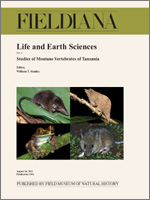During three field seasons between 1991 and 1993, we carried out rodent inventories of the East and West Usambara Mountains, Tanzania. The general trapping protocol used involved both pitfall lines and trap lines (Sherman, Victor, and Museum Special traps), with a limited number of animals trapped within and outside of forest habitats by local people. A total of 885 individual rodents, representing 15 species, were collected during this study. For the East and West Usambara Mountains, 13 (12 native) and 12 (all native) rodent species were recorded, respectively. Most rodents were captured by trap lines (96.6%); a few individuals were captured in the pitfall devices or brought to us by local people. The major exception is that all individuals of Dendromus (n = 11) obtained during the survey were in pitfall buckets.
A total of 18,563 sample-nights were accrued over the three years, including 11,339 sample-nights (3314 pitfall-nights and 8025 trap-nights) in the East Usambara and 7224 sample-nights (1924 pitfall-nights and 5300 trap-nights) in the West Usambara Mountains. Based on species accumulation curves, no previously unrecorded species was trapped after 11,064 sample-nights in the East Usambara and after 5213 sample-nights in the West Usambara. However, a previously untrapped rodent (Graphiurus kelleni) was captured in the East Usambara on the third-to-last of 59 sampling days, suggesting that other non-canopy–restricted rodent species may have been missed during this survey. In a series of species accounts, information regarding the natural history of the different taxa handled during these surveys, including distribution, ecology, and condition of sexual organs, a list of referable specimens, and the trap devices that collected them, are presented.
Trap and bucket lines combine to effectively sample most small- to medium-sized rodents. However, larger scansorial and canopy-restricted (squirrel) and fossorial (mole rat) species were not captured with our trapping methods, and these tabulations should not be considered a complete list of the small mammals of the Usambaras.





